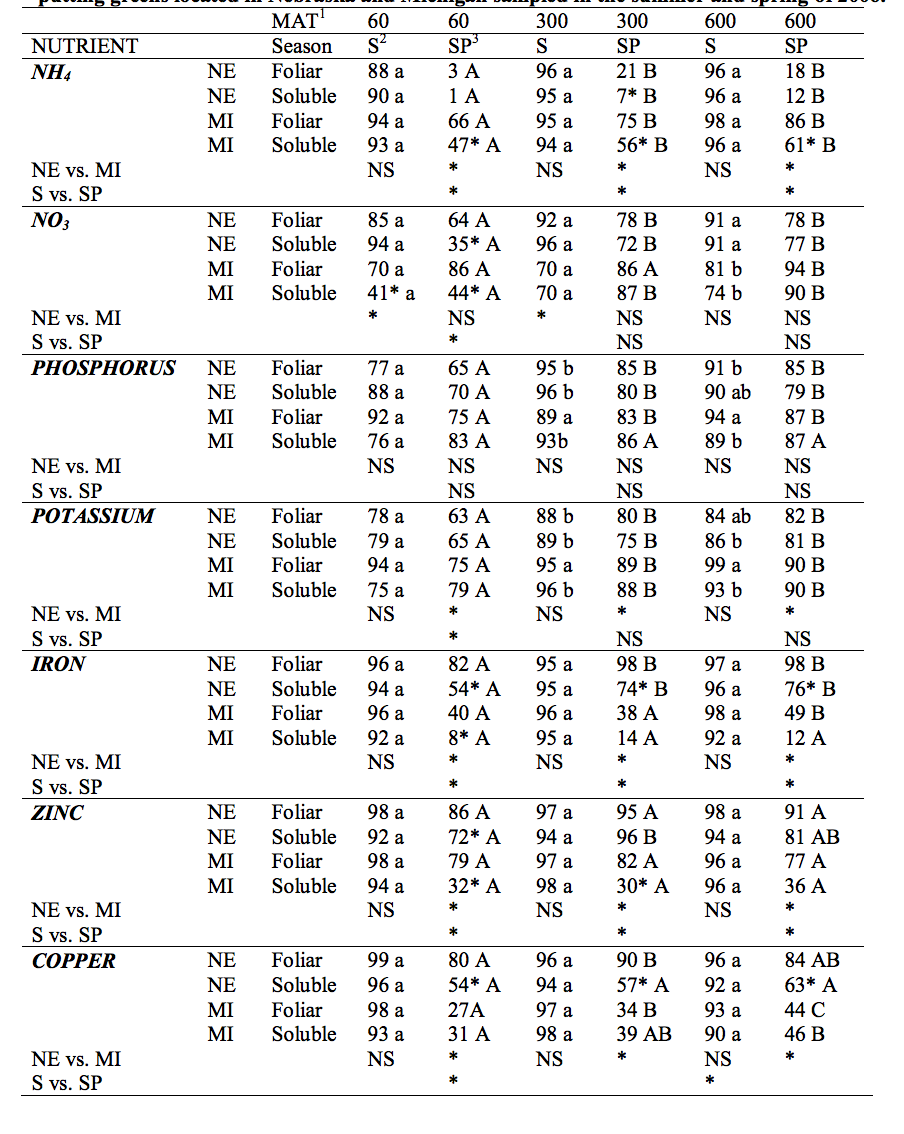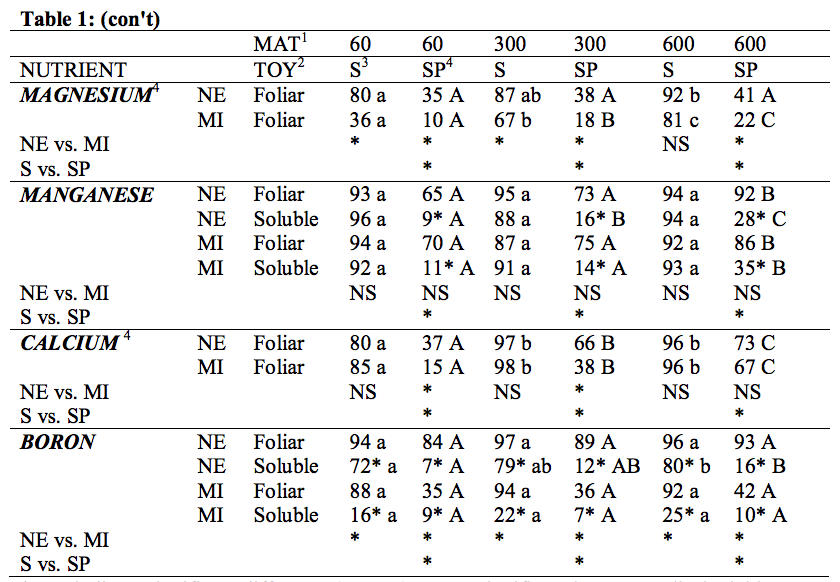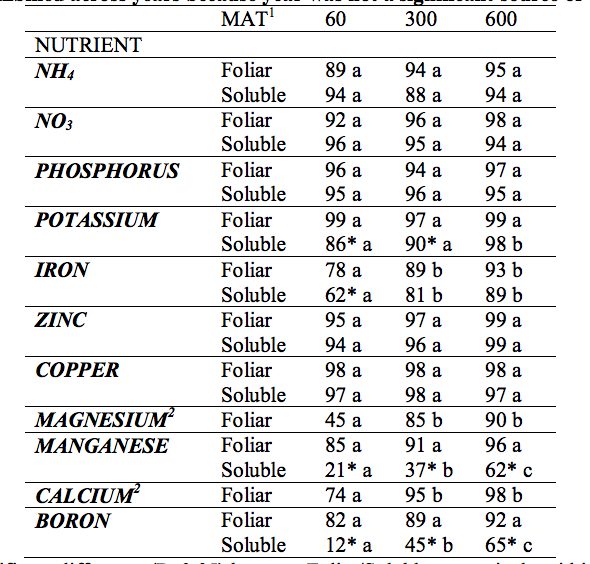Foliar Uptake of Nutrients Applied in Solution to Various Grasses
Foliar uptake of nutrients applied in solution to Creeping Bentgrass, Annual Bluegrass (Poa annua), and Ultra-Dwarf Bermudagrass (2009)
Peer Reviewed Title
Foliar uptake of nutrients applied in solution to Creeping Bentgrass (Agrostis palustris Huds.), Annual Bluegrass (Poa annua var. reptans (Hausskn.) Timm) and Ultra-Dwarf Bermudagrass (Cynodon dactylon x C. transvaalensis Burtt-Davy).
Author
Gaussoin, Roch, University of Nebraska-Lincoln Schmid, Charles, University of Nebraska-Lincoln Frank, Kevin, Michigan State University Butler, Tim, Michigan State University Liu, Haibo, Clemson University Jarvis, William III, Clemson University Baldwin, Christian, Clemson University Publication Date: 06-24-2009
Series
The Proceedings of the International Plant Nutrition Colloquium XVI
Publication Info
The Proceedings of the International Plant Nutrition Colloquium XVI, Department of Plant Sciences, UC Davis, UC Davis
Permalink
http://www.escholarship.org/uc/item/16j7j53q
Keywords
turfgrass, putting green, foliar absorption
Abstract
Liquid applications of nutrients to turfgrass are a routine management practice. A better understanding of nutrient chelating chemistry coupled with a measurable increase in products marketed to turfgrass professionals purported to facilitate effective and efficient absorption of nutrients into turfgrass leaves has resulted in a need for a better understanding of the capacity of turfgrass species to absorb essential nutrient elements. Research was conducted with the objectives to 1) determine the foliar uptake of nutrients in solution to Creeping Bentgrass (Agrostis palustris Huds.), Annual Bluegrass (Poa annua var. reptans (Hausskn.) Timm) and Ultra-Dwarf Bermudagrass (Cynodon dactylon x C. transvaalensis Burtt-Davy).and 2) determine temporal, location and seasonal differences in foliar uptake among these same species. Based on the results of this study it was found that foliar uptake was significantly affected by source of nutrient with organic chelating agent, when differences were identified, facilitating greater uptake vs. synthetic eScholarship provides open access, scholarly publishing services to the University of California and delivers a dynamic research platform to scholars worldwide. (i.e. EDTA) chelation. Time of year affected absorption efficiency with cooler temperature resulting in lower uptake. This is speculated to be highly influenced by ambient temperatures at time of application. Volatility losses were not measured in this study so caution should be exercised for interpretation of nitrogen results, especially NH4. The species investigated exhibited appreciable uptake of nutrients applied in solution. Liquid applications and more specifically, organically chelated foliar products, could reduce total nutrient applications and decrease potential for surface and ground water contamination due to decreased migration of select nutrients to the root zone.
Introduction
Liquid applications of nutrients to turfgrass are a routine management practice. Originally this practice was confined to N fertilizers including urea, ammonium nitrate and ammonium sulfate. While often not intentionally applied for foliar uptake, evidence exists for direct absorption of N into turfgrass leaves when these fertilizers are applied in solution (Eliot, 1960; Eliot, 1972; McCaslin and Watson, 1977; Rieke et al., 1982; Wesly et al., 1985; Spangenberg et al., 1986; Bowman and Paul 1989; Bowman and Paul 1990; Bowman and Paul 1992; McCarty, et al., 1994; Totten, 2006). In addition to N, elements such as Fe, Mg, B, and Ca have been investigated as liquid fertilizers to turfgrass (McCaslin and Watson, 1977; Fu and Huang, 2003; Stiegler et al., 2003; Guertal, 2004). A better understanding of nutrient chelate chemistry, coupled with a measurable increase in products marketed to turfgrass professionals purported to facilitate effective and efficient absorption of nutrients into turfgrass leaves, has resulted in a need for a better understanding of the capacity of turfgrass species to foliar absorb essential nutrient elements. Additionally, identification of technologies which facilitate more efficient absorption could potentially decrease fertilizer application rates as well as surface and ground water contamination, resulting in more sustainable turfgrass fertility practices.
Research was conducted with the objectives to: i) determine the foliar uptake of nutrients in solution to creeping bentgrass (Agrostis palustris Huds.), annual bluegrass (Poa annua var. reptans (Hausskn.) Timm) and ultra-dwarf bermudagrass (Cynodon dactylon x C. transvaalensis Burtt-Davy), and ii) determine temporal, location and seasonal differences in foliar uptake among the same species.
Materials and Methods
Two fertilization treatments and an untreated control were studied. The “Soluble” treatment represents a product which is not marketed for foliar absorption but instead for liquid application of nutrients. The characteristics of this product can be found at: http://www.andersonsgolfproducts.com/PDF/Products/AGC84320_spec.pdf This product contains soluble macro and micro nutrient forms and EDTA-chelated micronutrients. The “Foliar” treatment represents a product marketed for foliar absorption. The characteristics and description for this treatment can be found at: www.grigg.co. This treatment is labeled by the company as the “Tournament Program” and includes several active ingredients, including soluble macronutrients, organically chelated micronutrients, bio-stimulants (primarily amino acids and a seaweed extract) and a wetting agent.
Research was conducted at three field locations in 2006, the Agricultural Research and Development Center (at the University of Nebraska-Lincoln), The Hancock Turfgrass Research Center (at Michigan State University) and Clemson University in South Carolina. Creeping bentgrass (cv. „L-93‟) in Michigan and Nebraska, annual bluegrass (native population) in Michigan and Ultra-Dwarf bermudagrass (cv. „Champion‟) in South Carolina were managed at each site with typical, regional based practices for putting greens.
The use of nutrient isotopes provides an accurate research tool to comprehensively quantify nutrient absorption and movement in plants (Boynton, 1954). The concept of using radio-labeled isotopes for this purpose was first introduced in the early 1950‟s and is widely accepted as a viable research approach. Unfortunately, the screening of numerous elements is expensive, requires special training for isotope handling and involves potential health and environmental hazards of radio-labeled elements such as P. Also, the short half-life of nutrients such as radio-labeled Ca and the unavailability of radioisotopes for nutrient and their corresponding chelating agents contained within commercially available products makes using radioisotopes problematic for the objectives of this research.
Therefore, an alternative method described by Hall et al (2000) was modified based on a post application aqueous wash to the fertilized turf. Nutrient treatments were applied with a CO2 propelled backpack sprayer calibrated to deliver 720 L ha-1 at 276 kPa. A round plastic food preservation container (GladWare, Glad Corp, www.glad.com) was placed on the turf prior to treatment application. The material captured in the container was diluted with 250 mL of deionized water. At preset time intervals (60, 300 and 600 min after treatment (MAT)) after application a circular soil probe of the same diameter as the GladWare was used to extract intact cores to a depth of 15 cm. The grass surface of these cores was washed with 250 mL of deionized water and the wash water collected in a pre-labeled sample bottle. In addition, cores from untreated turf were subjected to the same procedure to account for surface contamination of the nutrients of interest. Absorption percentage for each nutrient was calculated as:
where nc = nutrient concentration
All samples were analyzed by Harris Laboratory (www.mdsharris.com). Initially a methanol wash was done immediately after the water wash to account for nutrients in the cuticle. Test runs indicated that this wash resulted in significant chlorophyll degradation and an inflation of elements such as Fe, Mn and Mg beyond the amount applied, and therefore the methanol wash was no longer used. Data were expressed as percent foliar/cuticular absorption to include elements which may have been retained in the cuticle. Not accounted for was nutrient volatility. Previous research has shown volatility losses to be significant for N compounds (Hogan et al., 1983; Wesley et al., 1987; Petrovic, 1990). Work with other nutrients is still limited or nonexistent, but Steigler et al. (2007) have reported much lower volatility losses (<7%). While the inability in this study to account for these N losses is problematic the remaining elements evaluated should be, based on physical chemistry, less prone to conversion from nutrient in solution to vapor.
Treatments were applied in the spring and summer of 2006 to creeping bentgrass and annual bluegrass and in two consecutive years (2006 and 2007) in August to bermudagrass. Experimental design was a randomized complete block with three replications. Treatment design was a 3 (fertility treatment) X 3 (MAT) X 2 (season or year) factorial. Data for each species were analyzed separately. Locations for creeping bentgrass (MI and NE) were included as a main effect and analyzed as a split-block, repeated in time experimental design with the aforementioned factorial treatment arrangement.
Results
Results for creeping bentgrass are shown in Table 1. When statistically significant, summer resulted in higher uptake then spring applications. Frequently this increase in uptake was more than 2X. A possible explanation may be reduced temperatures for the spring applications. Weather data from on-site stations indicated a 10-140 C difference between applications applied in the spring and summer. Location differences may be similarily explained. Ambient temperatures on spring dates of application were 4 ºC cooler for Nebraska than for Michigan. Temperature has been found to significantly impact absorption of nutrients applied in solution (Wittwer et al., 1959). Annual bluegrass exhibited very similar results to creeping bentgrass at the Michigan location (Table 2) with spring applications at lower temperatures resulting in decreased absorption. In both creeping bentgrass locations and in the annual bluegrass one, when large statistical differences between sources of nutrients were identified the foliar treatment exhibited a greater absorption than the soluble one. The improved efficiency with organic based chelates has been previously reported (Ashmead, 1986; Jeppsen, 1999). Bermudagrass (Table 3) exhibited a similar source response that was consistent in response across both years of the study (i.e., year was not a significant source of variability), and therefore data were combined across years. Temperature differences were less evident than those exhibited by annual bluegrass and creeping bentgrass, with <3˚ C ambient temperature difference between application dates in 2006 and 2007. All species (Tables 1-3) exhibit an increased nutrient uptake over time.
Conclusions
Foliar uptake was significantly affected by source of nutrient with organic chelating agent, when differences were identified, facilitating greater uptake vs. synthetic (i.e. EDTA) chelation.
Time of year affected absorption efficiency, with cooler temperatures resulting in lower uptake. We speculate that this may be due to differences in ambient temperatures at time of application.
Volatility losses were not measured in this study, so caution should be exercised for interpretation of nitrogen results, especially NH4.
The species investigated exhibited appreciable uptake of nutrients applied in solution. Liquid applications and more specifically organically chelated foliar products could reduce total nutrient applications and decrease potential for surface and ground water contamination due to decreased migration of select nutrients to the root zone.
References
Ashmead H.D. 1986. Foliar Feeding of Plants With Amino Acid Chelates, (Park Ridge: Noyes) 204-218.
Bowman, D.C. and J.L. Paul. 1989. The foliar absorption of urea-N by Kentucky bluegrass turf. J. of Plant Nutrition. 13: 659-673.
Bowman, D.C. and J.L. Paul. 1990. The foliar absorption of urea-N by tall fescue and creeping bentgrass turf. J. of Plant Nutrition. 13: 1095-1113.
Bowman, D.C. and J.L. Paul. 1992. Foliar absorption of urea, ammonium, and nitrate by perennial ryegrass turf. J. Amer. Soc. Hort. Sci. 117:75-79.
Boynton, D. 1954. Nutrition by foliar application. Annual Review of Plant Physiology. 5: 31-54. Eliot, R.C. 1960. Relationship between foliar and root development of turfgrass species and strains. Illinois Turfgrass Conference Proceedings. 32-35.
Eliot, R.C. 1972. The use of soluble fertilizers for lawn care. Proceedings of the 42nd Annual Michigan Turfgrass. 1: 61-71.
Fu, J. and J. Huang. 2003. Effects of foliar application of nutrients on heat tolerance of creeping bentgrass. J. of Plant Nutrition. 26: 81-96.
Guertal, E.A. 2004. Boron fertilization of bentgrass. Crop Sci. 44: 204-208.
Hogan, M.E., I. E. Swift, and J. Done. 1983. Urease assay and ammonia release from leaf tissues. Phytochemistry 22: 663-667.
Hall, G.J., C.A. Hart and C. A. Jones. 2000. Plants as sources of cations antagonistic to glyphosate activity. Pest. Mngnt. Sci. 56:351-358.
Jeppsen, R. 1999. Advantages of metal amino acid chelates in foliar absorption. Proc. Albion‟s Int.l Conf. on Plant Nutrition. 16-28.
McCarty, L.B, G.H. Snyder, and J.B. Sartain. 1994. Foliar feeding: How effective and safe is it? Florida Turf Digest. 11: 16-19.
McCaslin, B.D and C.E. Watson. 1977. Fertilization of common bermudagrass Cynodon dactylon L. with foliar application of iron. New Mexico Agricultural Experiment Station, State College. No. 334. p. 4.
Petrovic, A. M. 1990. The fate of nitrogenous fertilizers applied to turfgrass. J. Environ. Qual. 19: 1-14.
Rieke, P.E., S.L. McBurney, and R.A. Bay. 1982. Turfgrass soils report - effect of foliar applications of urea nitrogen and ferrous sulfate on quality of Adelphi Kentucky bluegrass. Proceedings of the 53rd Annual Michigan Turfgrass Conference. Vol. 12: 24-25.
Stiegler, J.C., G.E. Bell, and D.L. Martin. 2003. Foliar applications off magnesium and iron encourage annual bluegrass in shaded creeping bentgrass putting greens. On-Line Applied Turfgrass Science, published 21 August, 2003.
Stiegler, C., M. Richardson, J.McCalla, J. Landreth and T. Roberts. 2008. Indirect measurement of ammonia volatilization following foliar applications of urea on a cool- and warm-season putting green turfgrass species. Arkansas Turfgrass Report 2007, Ark. Ag. Exp. Stn. Res. Ser. 557:80-84.
Totten, F.W. 2006. Long-term evaluation of liquid vs. granular nitrogen fertilization in creeping bentgrass. Ph.D. Dissertation. Clemson University, Clemson, SC.
Wesly, R.W., R.C. Shearman, and E.J. Kinbacker. 1985. Foliar N-uptake by eight turfgrass grown in controlled environment. J. Amer. Soc. Hort. Sci. 110: 612-614.
Wesly, R.W., R.C. Shearman, E.J. Kinbacher, and S.R. Lowry. 1987. Ammonia volatilization from foliar-applied urea on field-grown Kentucky bluegrass. HortSci. 22: 1278-1280.
Wittwer, S.H. and F.G. Teubner. 1959. Foliar absorption of mineral nutrients. Annual Review of Plant Physiology. 10: 13-30.
Table 1: Percent foliar/cuticular absorption of nutrients applied in solution to creeping bentgrass putting greens located in Nebraska and Michigan sampled in the summer and spring of 2006.


*, NS indicate significant difference (P=0.05) or non-significant between Foliar/Soluble respectively within nutrient and/or between seasons and location.
Numbers within rows with different lower-case letters indicate significant differences (P=0.05) over time of application for summer application
Numbers within rows and with different upper-case letters indicate significant differences (P=0.05) over time of application for spring application
1 Minutes after treatment
2 Summer
3 Spring
4 not contained in Soluble treatment
Table 2: Percent foliar/cuticular absorption of nutrients applied in solution to annual bluegrass greens located in Michigan and sampled in the spring and summer of 2006.

*, NS indicate significant difference (P=0.05) or non-significant between Foliar/Soluble respectively within nutrient and/or between seasons
Numbers within rows with different lower-case letters indicate significant differences over time of application for summer application
Numbers within rows and with different upper-case letters indicate significant differences over time of application for spring application
1 Minutes after treatment
2 Summer
3 Spring
4 not contained in Soluble treatment
Table 3: Percent foliar/cuticular absorption of nutrients applied in solution to ultra-dwarf bermudagrass greens located in South Carolina and sampled in August of 2006 and 2007 (data were combined across years because year was not a significant source of variation).

* indicate significant difference (P=0.05) between Foliar/Soluble respectively within nutrient.
Numbers within rows with different lower-case letters indicate significant differences (P=0.05) over time of application.
1 Minutes after treatment
2 not contained in Soluble treatment